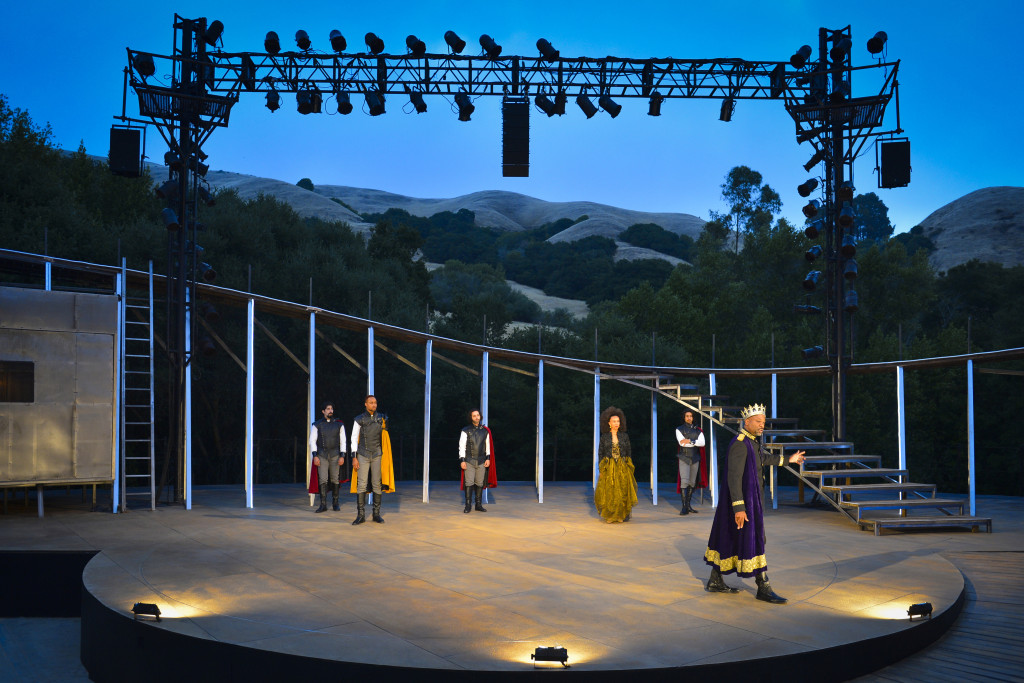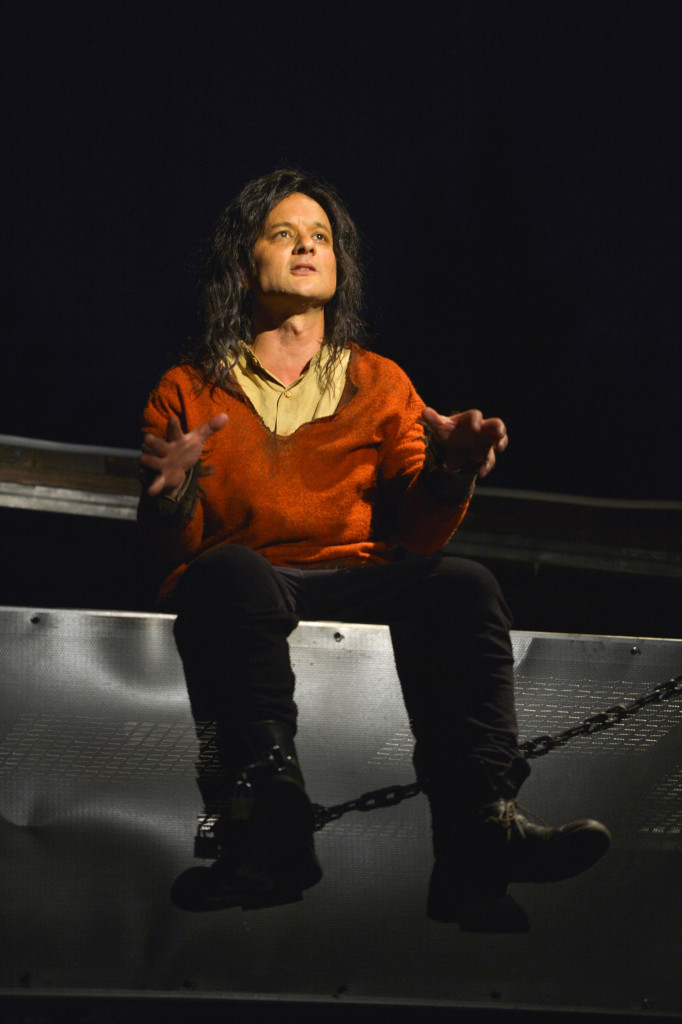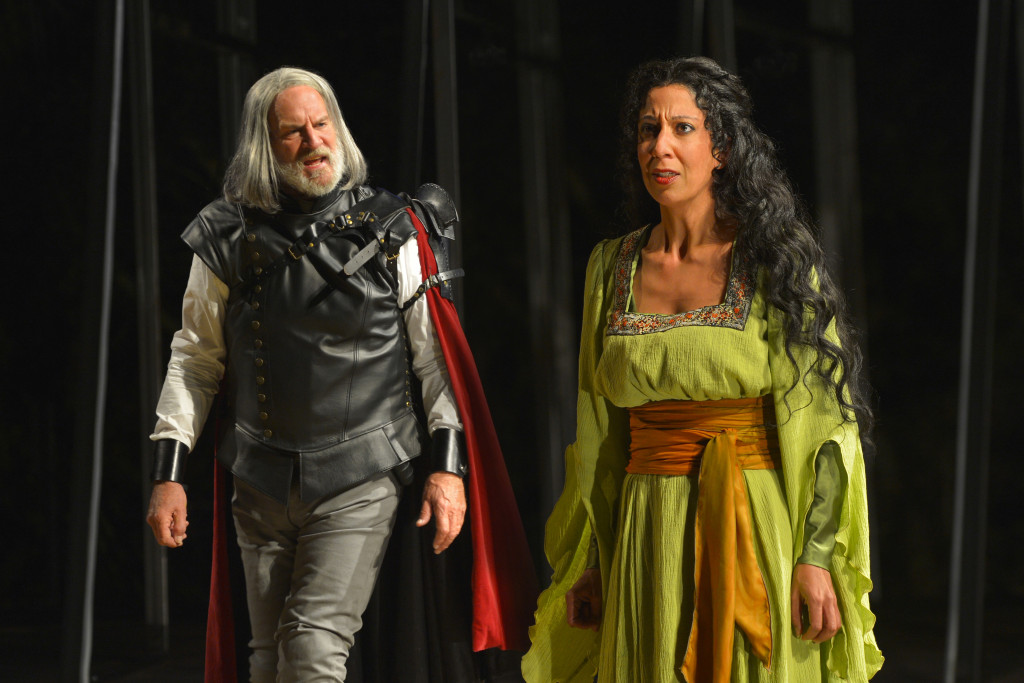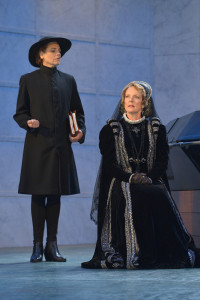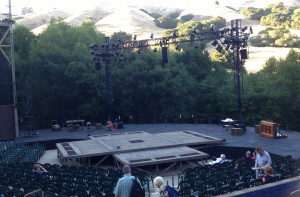What’s Your Problem?: A Review of MEASURE FOR MEASURE at CalShakes
September 27, 2017 § Leave a Comment
Measure for Measure, Shakespeare’s rhetorically brilliant but generically ambiguous “comedy,” is perpetually a problem. Tyne Rafaeli, directing for co-producers, the California Shakespeare Theater (CalShakes) and Santa Cruz Shakespeare, provides a fascinating approach that does not “solve” the difficult text (and in some ways complicates it even further) but does provide a set of visual tableaus and cleverly staged moments that make it especially relevant to the Bay Area audiences and the fraught political moment in which we live.
Why the play is so difficult is no particular mystery. Shakespeare adapted a completely tragic story (from the same source that he used for Othello) then – through the addition of a couple of hoary plot devices – restructured it into a comedy. Although everything does work out in the end, the tone of the play remains predominantly dark, however, so it is hard to know how lightly to take it and what to make of the moral dilemmas it poses.
Power and Perversion
The convoluted plot is the story of a Duke who is reluctant to exercise his power to maintain order, and so temporarily turns his duties over to a puritanical deputy with no such qualms. To set an example, the replacement ruler immediately sentences a young man to death for the relatively minor crime of impregnating his fiancé before marriage. The young man’s sister (a novice on the verge of taking her vows to become a nun) makes an impassioned argument for his life, which perversely just excites the cold deputy’s lust. He propositions her, offering the brother’s life in return. Faced with what is known in literature as the monstrous bargain she refuses. “More than our brother,” she declares, “is our chastity” – a position that modern audiences, at least, do not always find sympathetic.
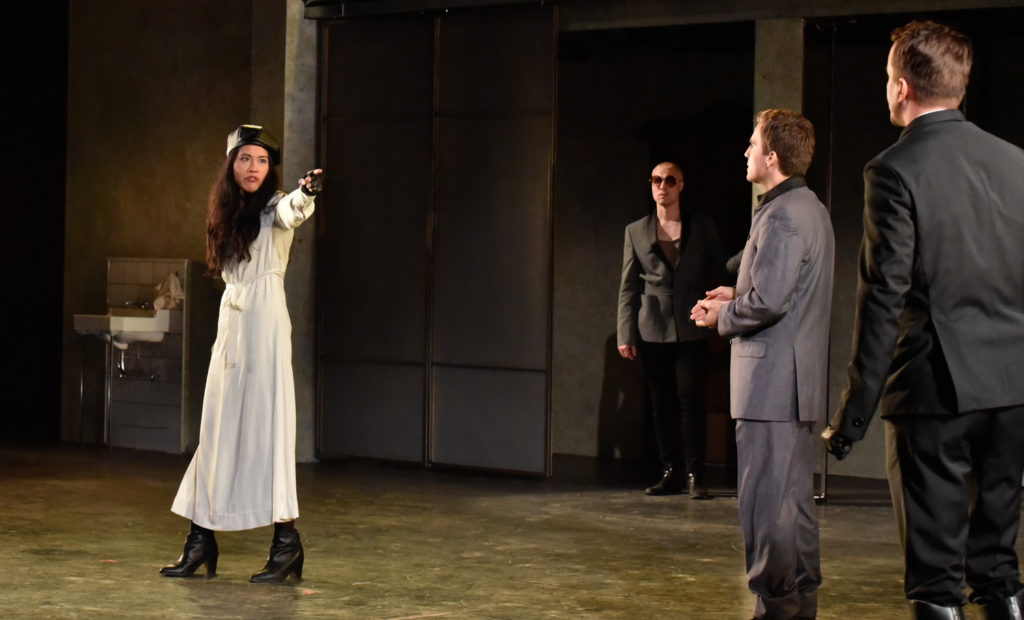
(L to R) Lindsay Rico (Isabella), Adam Schroeder (Lucio), Rowan Vickers (Duke) and David Graham Jones (Angelo) in California Shakespeare Theater’s MEASURE FOR MEASURE, directed by Tyne Rafaeli; photo by Jana Marcus.
Oddly, the Duke is lurking about in disguise and convinces the heroine to pretend to assent, and then substitutes the deputy’s rejected fiancé in the darkened bedroom. In a not-all-that-shocking twist the deputy, even though he is fooled by the substitution, still orders the execution to go ahead. The Duke has to struggle around in the background to prevent tragedy, and eventually resumes his position in order to set things right – just not until after he has convinced the young man that will have to die, convinced his sister that he did die, and convinced the hypocritical underling that he got away with it all. (Although manipulative, it is probably supposed to have a Big Yellow Taxi effect.) By the time the ending comes, when the Duke proposes to the would-be nun, the audience has been bounced between the poles of starkest tragedy and melodramatic relief several times.
Visualizing Psychology
Rafaeli imbues her production with an artificial urgency throughout, which makes it all look and feel much more like a farce. This certainly reduces the tonal whiplash we usually experience in productions of this title – but also rushes the detailed explanations of what is happening (and why) to the point that it is often far from clear to anyone not already familiar with the play what is transpiring.
What is genuinely original, and pretty wonderful, about the production is how Rafaeli makes many of the most difficult assumptions in the play more comprehensible through striking visual compositions. She stages the propositioning scene as a graphic sexual assault, sending the heroine initially into frozen shock – a haunting tableau that sums up the abuse of power and the helplessness of victims in a single image. Isabella’s subsequent revulsion at the idea of having sex, even to save her brother’s life, becomes psychologically comprehensible. (Given that we are living under a happily “pussy-grabbing” president, it also makes it inevitably political.)
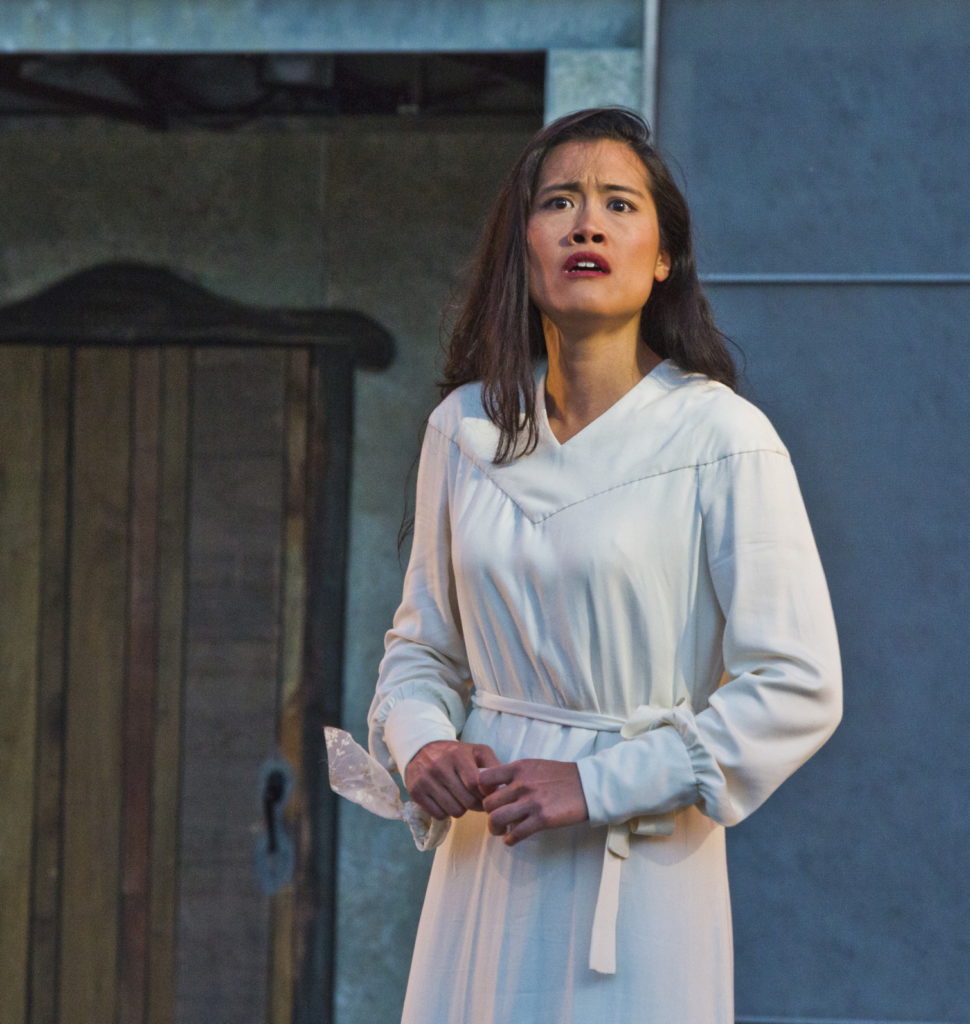
Lindsay Rico (Isabella) in California Shakespeare Theater’s MEASURE FOR MEASURE, directed by Tyne Rafaeli; photo by rr jones.
Her brother, whose punishment vastly outweighs his crime, is played by an actor of color. Rafaeli’s staging of his scenes of imprisonment with starkly contemporary details to the cell is surely meant to remind us of the injustices of our current system that disproportionately imprisons black and Latino men. A stumbling block for many Measure for Measure audiences is often that they find the overly-harsh sentence silly instead of serious, but in Rafaeli’s context it is all too plausible – again speaking to both the local audience and current moment.
A Different Kind of Setting for CalShakes
Throughout the play, Rafaeli uses the broad, shallow setting to create quick visual snapshots of important moments that remind us of nothing so much as eye-popping comic book panels freezing the action into bold compositions. Although wide and flat, Annie Smart’s set is both functional and effective for this purpose. It is very unlike the usual stage sets in CalShakes’ outdoor location where seeing into the far distance is possible. Montana Levi Blanco’s modern dress costumes often border on the whimsical. It is Kent Dorsey’s lighting that ultimately makes Rafaeli’s visual summaries burn into our consciousness.

Adam Schroeder and Annie Worden in Montana Levi Blanco’s fantastical costumes.
There are No Small Parts
To achieve the contemporary resonance, both verse speaking and self-conscious rhetoric were sacrificed to more physical approaches. As a result, the small players were often the most interesting members of the cast, especially Annie Worden’s rapid-fire turns as the Mistress Overdone, the Dogberry-like constable Elbow, the belligerent drunk, Barnadine, who farcically refuses to be executed, and Mariana, the heartbreakingly rejected fiancé of the false deputy who finally reclaims him from his own hypocrisy. CalShakes favorites Tristan Cunningham and Patty Gallagher also produce compelling and varied performances across a number of roles, as does newcomer Kevin Matthew Reyes as the brother, Claudio, and his polar opposite, the amusing pimp Pompey.
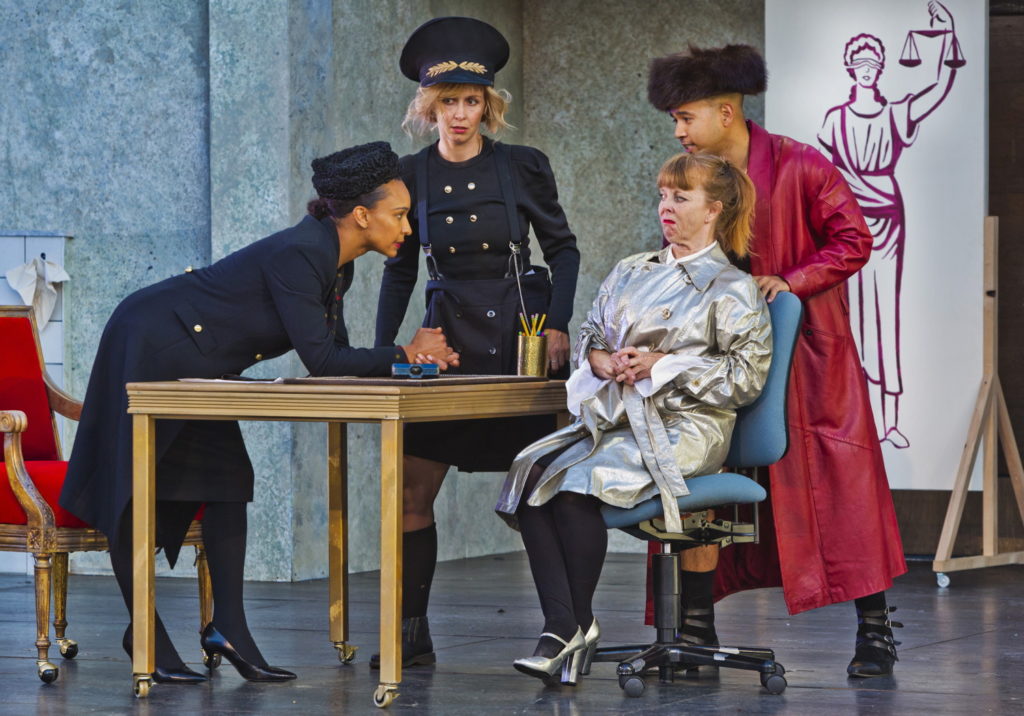
(L to R) Tristan Cunningham (Escalus) and Annie Worden (Elbow) question Patty Gallagher (Froth), and Kevin Matthew Reyes (Pompey) in California Shakespeare Theater’s MEASURE FOR MEASURE, directed by Tyne Rafaeli; photo by rr jones.
In the end, this production was a reminder that there is no such thing as a definitive staging of any Shakespeare play. There are endlessly fascinating possibilities, however. Measure for Measure is often a showcase for exceptional voices and fine verse speaking. It is almost unique to see it staged as a director’s vehicle emphasizing visual pictures and physical comedy. It is hard for me to remember any production of this show that was so closely tuned to place and time in which it was presented.
A Classic Reborn: a Review of BLACK ODYSSEY at CalShakes
August 14, 2017 § Leave a Comment
At the center of poet/playwright Marcus Gardley’s black odyssey (now playing at the California Shakespeare Theater) is the eternal impulse to retell a classic tale in order to claim it as one’s own. For those of us who regularly teach the classics, this is the lesson we seek to foster: the purpose of retelling these stories is not to perpetuate the past, but to connect to it. It is impossible to leave Eric Ting’s masterful production without feeling a part of something bigger than one’s own limited space and time.
A Paradox
Gardley’s reworking of the Homeric epic gains its force from the paradoxical rule that universality is achieved not by vacuous generality, but in precise specificity. On its surface, his play is about an African-American veteran of the contemporary (and ongoing) war in Afghanistan, named Ulysses Lincoln, who cannot find his way home. Over the course of the evening it becomes clear, however, that he is not so much geographically lost as spiritually at sea. His journey is not just finding his home, but finding himself.
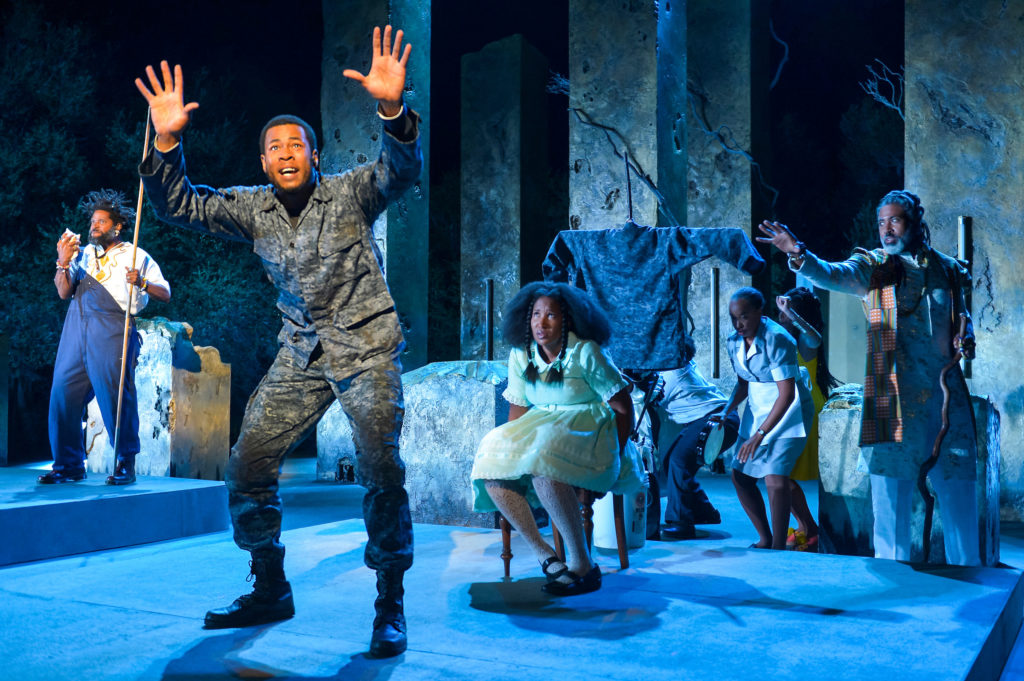
(l to r) Aldo Billingslea (Great Grand Paw Sidin), J. Alphonse Nicholson (Ulysses Lincoln), Safiya Fredericks (Benevolence Nausicca Sabine), Dawn S. Troupe (Alsendra Sabine) and Lamont Thompson (Great Grand Daddy Deus); photo by Kevin Berne
After being swept overboard of the ship carrying him home by a wave caused by the vengeful sea god, he washes up on a shore that – we slowly realize – is located both far from his intended destination and decades before he was born. The path to self-knowledge runs through the discovery of a history that was in some ways actively withheld from him through erasure and distortion, and in other ways that he actively fled when he joined the army to get himself out of Oakland. Although this is one man’s specific story, Gardley guides us to seeing beyond the surface, making it also a story about all of us.
Epic
Like any true epic, the plot is anything but linear. It is dotted with witty reïmaginings of the arbitrary and capricious Greek gods Paw Sidin (Poseidon), Aunt Tina (Athena) and Great Grand Daddy Deus (whose name is pointedly changed from Zeus to the Latin generic term for “god,” presumably because it also applies to the god of Christian tradition) who toy with human fate for reasons of their own. It retains the secondary story of the struggles of his wife, Penelope (here called Nella P.), and son, Telemachus (Malachai in Gardley’s version), to survive and retain hope, while placing them in a very recognizable 21st century Oakland. Often it focuses on the surreal experiences of the wandering Ulysses.
Along the way Gardley invokes Hurricane Katrina, the string of assassinations of civil rights leaders, Abraham Lincoln, JFK, Treyvon Martin, the death of Oscar Grant in the Fruitvale BART Station, reconstruction, and a host of other historical and local references that stir times and places together poetically. Painfully, I saw the opening night performance just hours after a white supremacist march in Charlottesville, Virginia, erupted in fatal violence against counter-protesters, which did not need to be directly referenced in order to be part of the mix.
A Great Feast of Language
Gardley is as much poet as playwright. His rhythms, rhymes and wordplay are both stunningly current and historically apt. For anyone who loves language black odyssey is a feast. CalShakes consistently demonstrates careful attention, not only to what is said, but how it is said. Gardley is at his most Homeric in his extravagant use of poetic artifice, and the producing company serves his inventive wit well.
The production heavily features music, especially arrangements of traditional spirituals. Vocal composers Linda Tillery and Molly Holm produced the strongest musical ensemble I have seen at CalShakes. (Tillery is also the credited Music Director, while Holm is also listed as Vocal Ensemble Director.) While I was less impressed with the brief forays into pop music in the second act, it is hard to underestimate how much of the overall impact of the production is built on the musical components. When the full cast is united in a choral moment, which happens rather often, the wall of sound they create is viscerally moving.
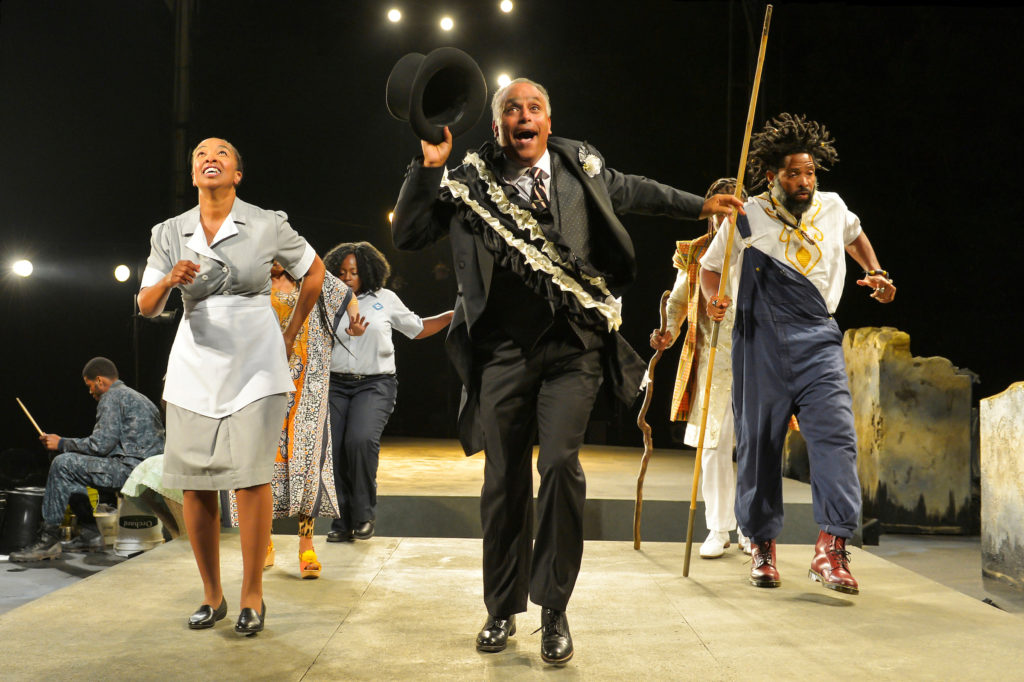
The cast of Marcus Gardley’s black odyssey directed by Eric Ting at California Shakespeare Theater; photo by Kevin Berne
Nine Stars
However much all of that matters, the evening is also about basking in the masterful performances of an exceptional cast. As Ulysses, actor/percussionist J. Alphonse Nicholson accomplishes the enormously challenging task of portraying a lost soul without fading from focus or losing his energy. His humanity and generosity as a performer letting us glimpse his innermost self allows us to identify with him intensely. Omozé Idehenre proves an emotional anchor for the entire evening as his long-suffering wife. Newcomer Michael Curry completes the family trinity as his son, Malachai, movingly and believably, even when the role shines an unsympathetic light on his character. In a conventional drama, this family grouping would be our entire focus and we would be content with such central performances.
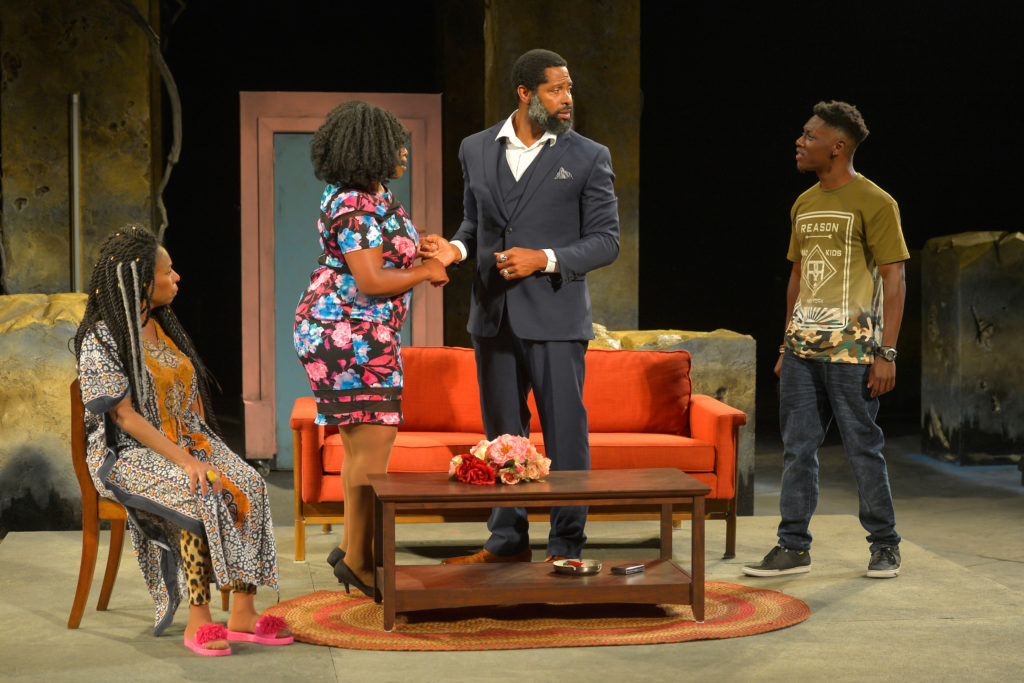
(l to r) Margo Hall (Great Aunt Tina), Omozé Idehenre (Nella Pell), Aldo Billingslea (Suitor), and Michael Curry (Malachai); photo by Kevin Berne
In this cast, however, the peripheral players are every bit as compelling. CalShakes regulars Aldo Billingslea and Margo Hall are powerhouses as the squabbling gods whose conflict lies behind Ulysses’ trials. Both also demonstrate astonishing versatility as they transform into their respective gods’ alter-egos. Billingslea invokes Paw Sidin as a coverall-clad levee fisherman but when he incarnates as a smooth-talking suit salesman wooing Nella P., a crisp military officer offering the wrong kind of solace when he brings news that Ulysses is lost and presumed dead, and a terrifying policeman, he appears completely different in each case. When Hall’s Athena sloughs off her immortality to become Aunt Tina, an aging and ill human, we see her change right before our eyes. And her invocation of Tina Turner (as one of the Sirens) is, well, let’s just say worth the price of admission all by itself.
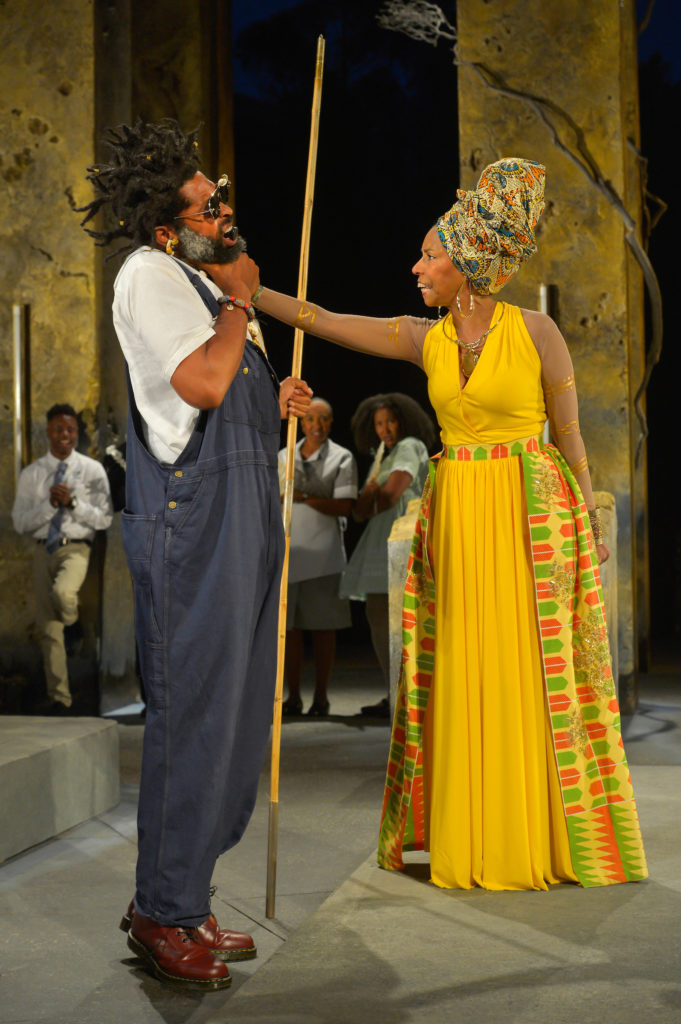
Foreground: Aldo Billingslea (Great Grand Paw Sidin), Margo Hall (Great Aunt Tina); rear: Michael Curry, Dawn L. Troupe, and Safiya Fredericks. Photo by Kevin Berne
Are these five great performers the magic number? Hardly. They are actually just the start of a cast of astonishing depth. Lamont Thompson as Daddy Deus is majestic, and in various minor roles he ranges from mysterious to hilarious. Bay Area playwright/performer Michael Gene Sullivan (best known for his work with the San Francisco Mime Troupe) appears – and sometimes disappears into – so many guises it’s hard to stay clear that it is the work of just one man and not a cast of dozens filling in. Dawn L. Troupe is Sullivan’s female equivalent in the cast playing a range of roles, sometimes prominent and sometimes almost invisible, providing enormous texture and depth to the play.
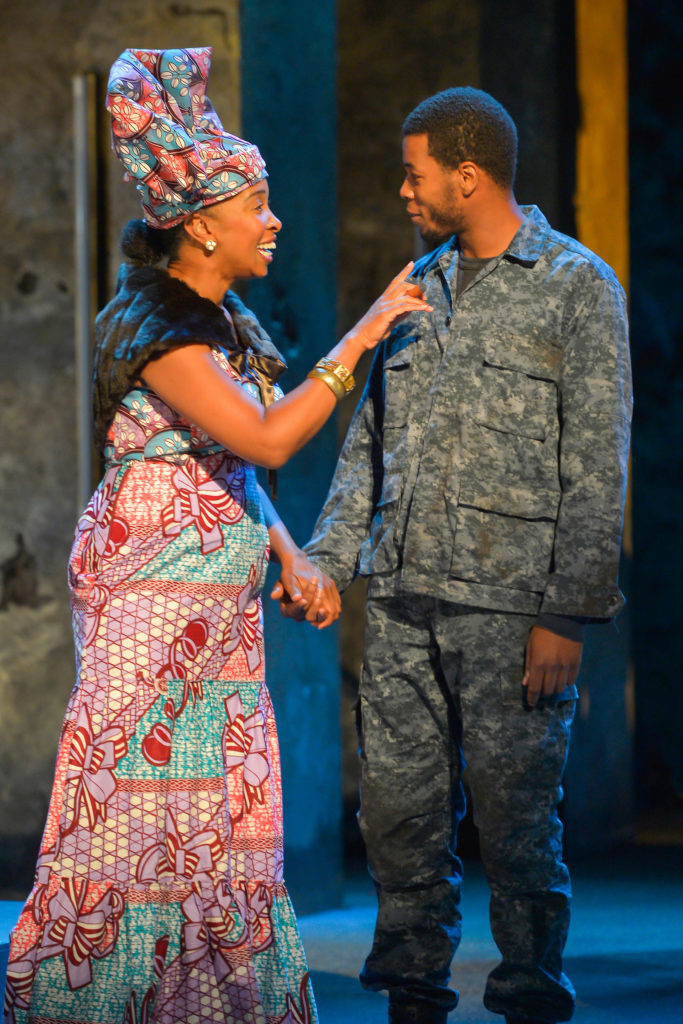
Dawn L. Troupe as Circe and J. Alphonse Nicholson as Ulysses Lincoln in Marcus Gardley’s black odyssey directed by Eric Ting at California Shakespeare Theater; photo by Kevin Berne
The nine-person cast is rounded out by Safiya Fredericks, whose light and amusing performance of Ulysses’ childish traveling companion conceals an artfulness and control that is only revealed when the entire play has unfolded. It is unfair that her masterful work cannot be discussed in detail without spoiling the play, but it can be said without harm that her genius lies in knowing when and how to unleash her talent, and it is worth the wait.
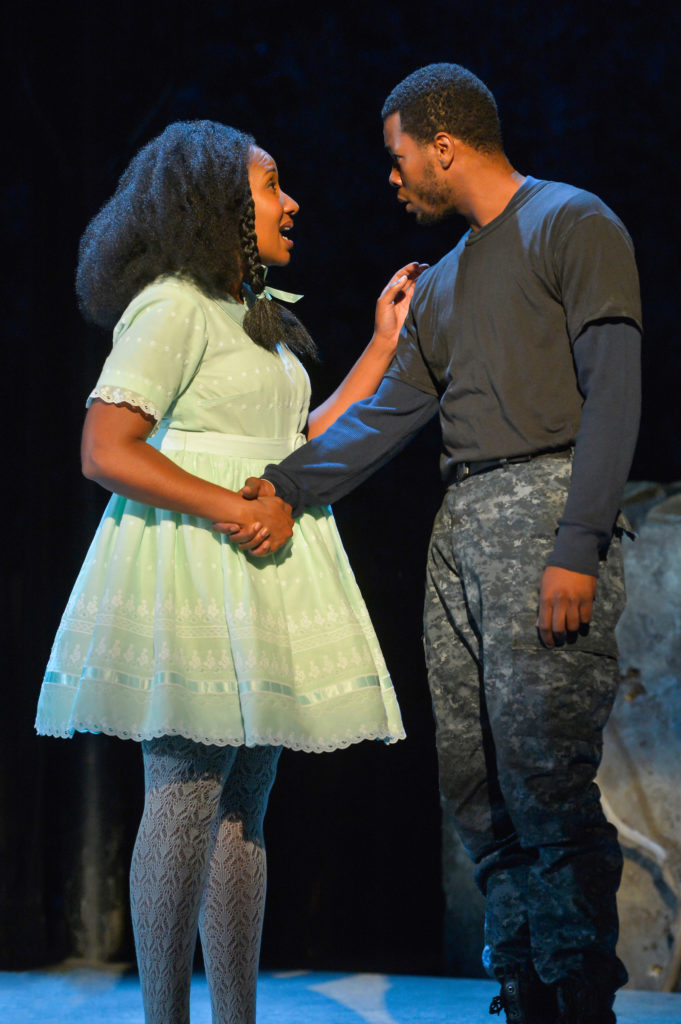
Safiya Fredericks (Benevolence Nausicca Sabine) and J. Alphonse Nicholson (Ulysses Lincoln); photo by Kevin Berne
One Small Man in a Huge World
The action of the play happens almost exclusively on an empty platform in front of Michael Locher’s monumental set, but the dynamic visual impression created by the towering (and crumbling) pillars sets the right tone throughout the night. Locher is especially successful at tying the stage space to CalShakes’ astounding natural setting in the Berkeley hills. That gorgeous view is always one of the pleasures of attending a CalShakes production. In a piece this grounded locally, it was especially admirable that the surrounding environment was featured. Abetted by the outstanding work of Lighting Designer Xavier Pierce, both the onstage action and the larger surroundings remain in balance. Thematically evocative, the image of one small man making his way in the huge world could not have been more beautifully rendered. Costumes by Dede M. Ayite successfully mix the mundane (for scenes of domestic depression) and the fantastic (in the otherworldly visions of Ulysses), which is not an easy trick to pull off.
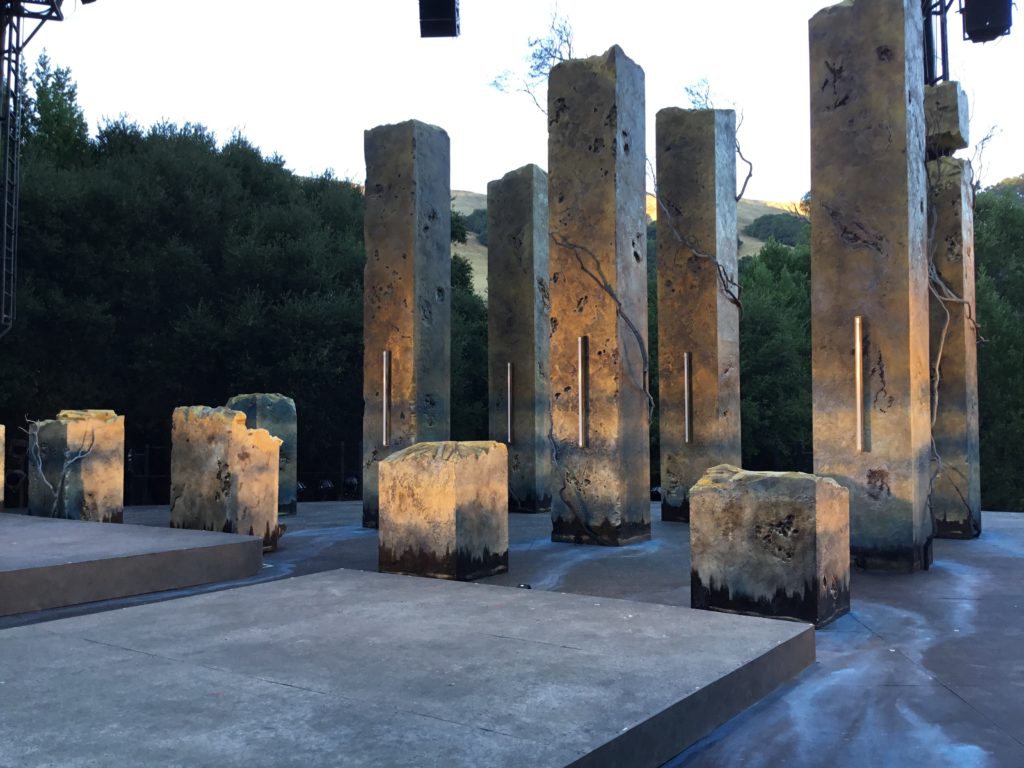
Michael Locher’s set lit by the pre-show sunset. Photo by the author.
Empathy
Ting’s directing is an astonishing act of empathy by a man who is, after all, of Asian-American decent, who is empowering an African-American cast to claim and interpret a story whose specifics are outside his direct experience. In his company debut as a director a year ago his Brechtian production of Othello proved controversial in part because (as is the way with such productions) we were not so much asked to empathize with Shakespeare’s hero, but told to do so. I am among those who actually like a stern lecture now and then and I liked Ting’s production, but I concede it was more Brecht than Shakespeare.
In this case, Ting seems an absolute servant to Gardley’s vision. It is hard for me to imagine that even those who found his Othello difficult will not find this an inviting experience. It is a sensitive and insightful rendition of a beautiful play, allowing a local playwright and cast to stake a claim on a work considered foundational to the Western tradition in a truly universal way. By making Homer their own they remind us that no one owns or directly inherits the past. We all have to find our humanity.
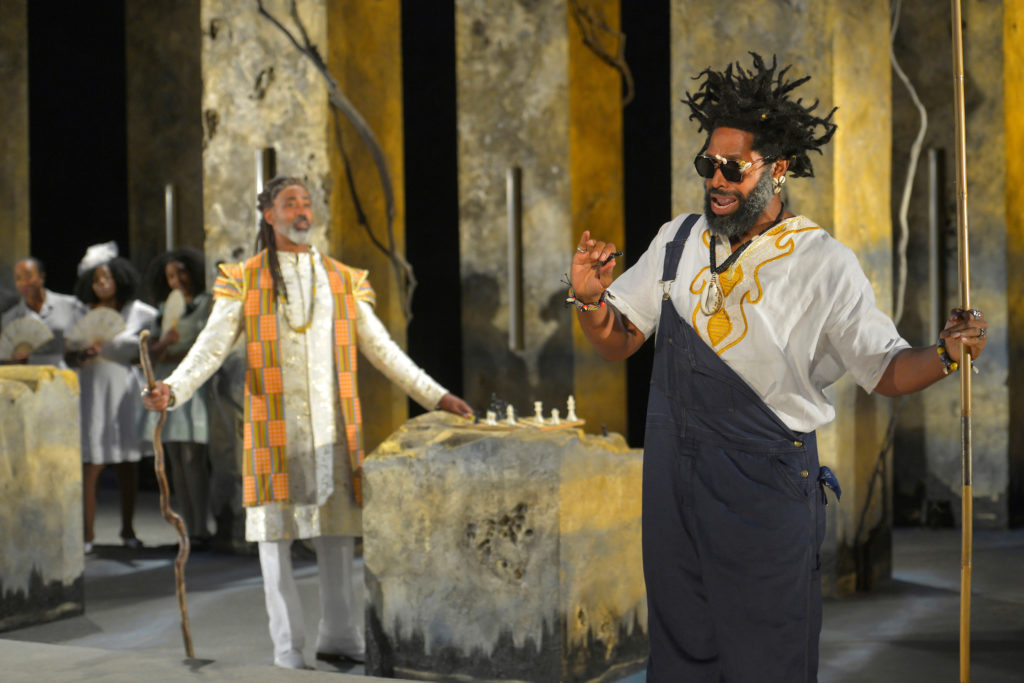
(l to r) Lamont Thompson as Great Grand Daddey Deus plays chess with Aldo Billingslea as Great Grand Paw Sidin, while Dawn L. Troupe, Omozé Idehenre, and Safiya Fredericks look on in Marcus Gardley’s black odyssey directed by Eric Ting at California Shakespeare Theater; photo by Kevin Berne
Production seen on August 12 2017
WHEN: through September 3, 2017
Tuesdays through Thursdays at 7:30pm, Fridays and Saturdays at 8pm, Sunday Matinees at 4pm
WHERE: Bruns Amphitheater, 100 California Shakespeare Theater Way, Orinda, CA 94563
INFO: www.calshakes.org
AS YOU LIKE IT, but like you’ve never seen it… at CalShakes
May 31, 2017 § Leave a Comment
Desdemona Chiang’s smart, contemporary production of As You Like It for CalShakes turns the play inside out, resulting in an extraordinarily moving and revelatory performance.
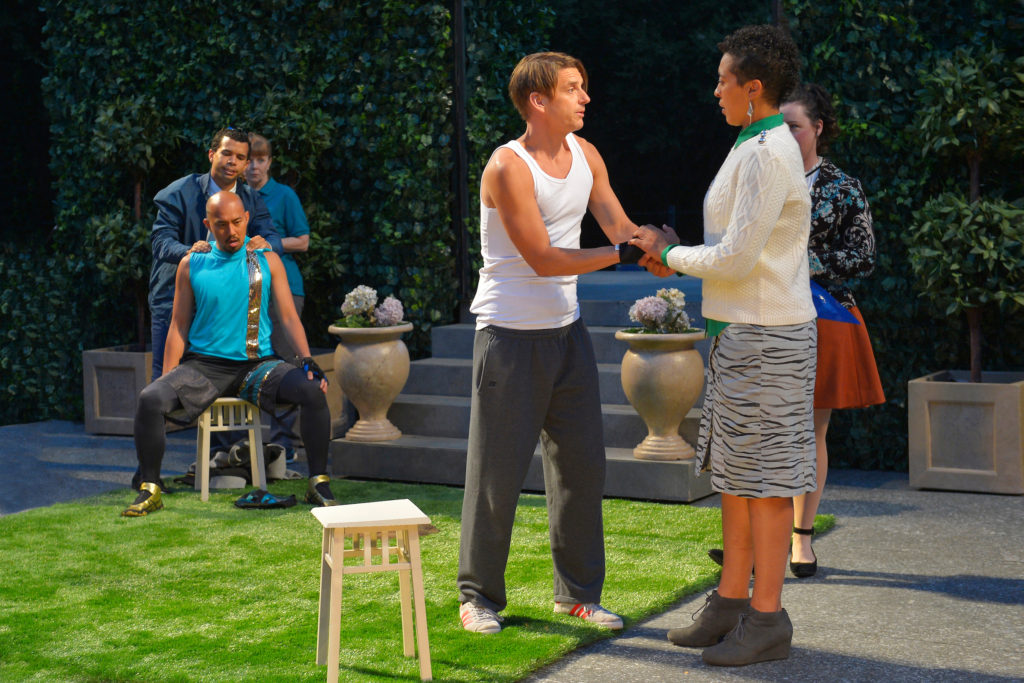
(L to R, front) Jomar Tagatac (seated) as Charles the Wrestler, Patrick Russell as Orlando and Jessika D. Williams as Rosalind photo by Kevin Berne.
Chiang takes everything we have come to expect from this pleasant (if usually light-weight) comedy and stands it on its head. From arrival in the auditorium until the curtain call, she finds unexpected depth and intensity by reimagining the setting, the period and the context of the show.
From Green World to Cityscape
The first glimpse of Nina Ball’s evocative set (waiting on the open stage of CalShakes’ beautiful outdoor location in the foothills just beyond Berkeley) is of a gorgeously manicured ivy-covered wall and topiary garden. Reversing the usual trope, this particular “green world” proves to be the unhappy home of the heroine, rather than the expected idyllic wood to which she will later be forced to flee.

Nina Ball’s beautiful “green wall” in the pre-show sunset.
When that heroine, Rosalind, is spitefully banished by her malicious uncle, she adopts male disguise and decides to seek her exiled father in the Forest of Arden. Ball’s set revolves and suddenly… we are in a dark, industrial back-alley, where the homeless and dispossessed occupy deserted loading docks stacked high with abandoned shipping containers. It is an apt contemporary analog for the dangerous backwoods of Shakespeare’s era, but unlike any design choice I have previously seen.
On the surface level, this resetting is not an easy fit. The rustics in the “woods” retain their pastoral concerns from deer hunting to sheep herding, while Rosalind (along with the cousin and court jester that agreed to accompany her) speak admiringly of the beauty of the place. The urban jungle we see and the idyllic pastoral vista we hear described are jarringly at odds.
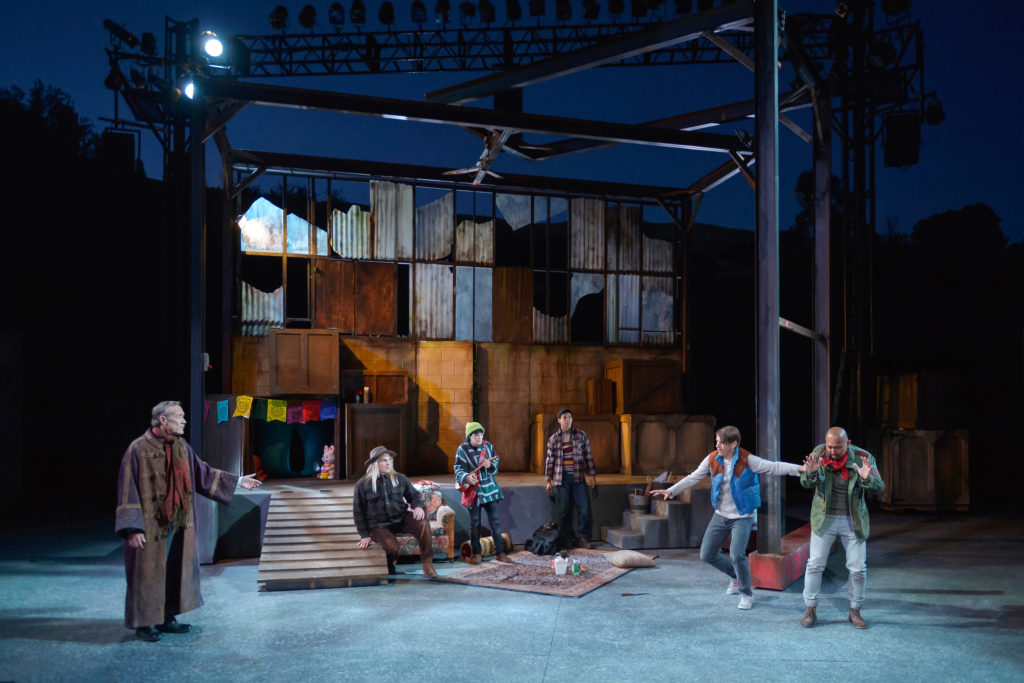
(L to R) James Carpenter (Duke Senior), Craig Marker (Amiens), Lisa Hori-Garcia (Second Lord), William Thomas Hodgson (First Lord), Patrick Russell (Orlando) and Jomar Tagatac (Jaques) on Nina Ball’s urban jungle set.
Chiang’s genius lies in slowly seducing us into an even-greater-than-usual suspension of disbelief so that we might look past these surface discordances and discover the play’s deepest core. Her allies in this are her exceptional design team, which in addition to Ball includes costume designer Melissa Torchia, lighting designer Masha Tsimring and sound designer Sharath Patel. They build a world that looks nothing like what is said to be their location, but feels exactly right for a place that is “uncivilized,” and therefore at once dangerous yet freeing.
Finding Ganymede
It is the performance of Jessika D. Williams as Rosalind that pushes the production to truly remarkable heights. In this dangerous new environment, her version of the protagonist has good reason to disguise herself as the male Ganymede, but in Williams’ interpretation what begins as a disguise becomes a discovery. Freed from social constraint, her Rosalind is not so much “performing” the part of a man as she is giving up “performing” the role of a woman. She finds a less-limited, stronger version of herself inside her disguise, and she likes it!
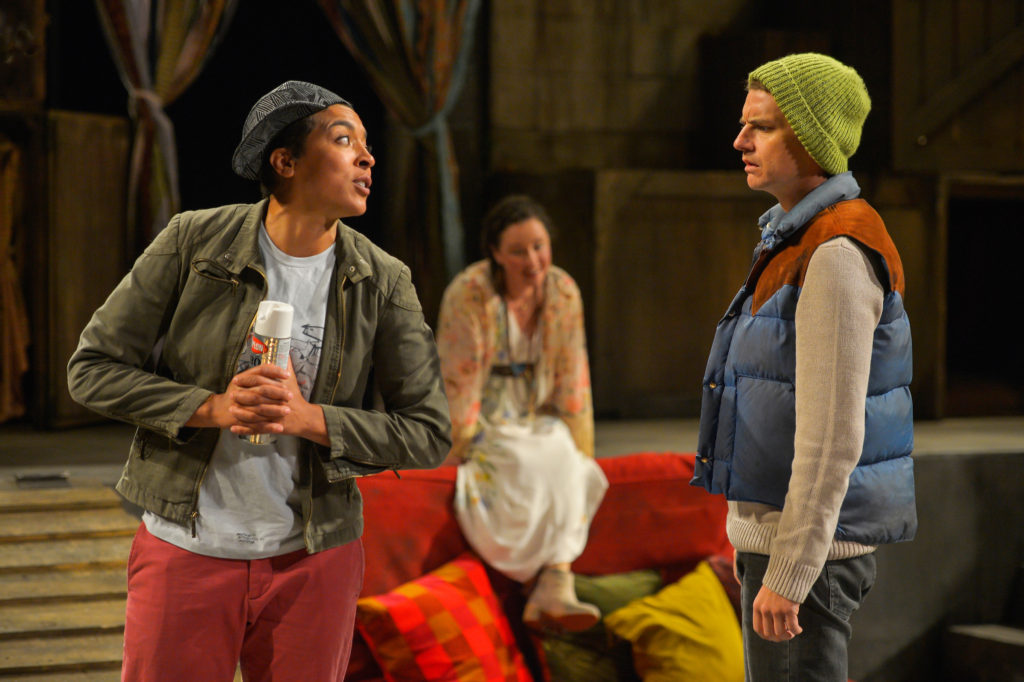
(L to R) Jessika D. Williams (Rosalind), Maryssa Wanlass (Celia), and Patrick Russell (Orlando), photo by Kevin Berne.
Patrick Russell plays her love interest, Orlando, more conventionally, but he has the courage to play his character as being as attracted to Rosalind’s male alter ego as he is to the “absent” Rosalind. Where he especially shines, however, is in a small scene usually played with a light touch where, penniless and hungry, he demands food at knife-point from a group of homeless people enjoying a communal meal. Rather than make fun of the character’s ineptitude at bluffing, Russell plays the scene with believable, fearful recklessness. Even while bringing sympathy to his character’s desperation, he nonetheless seems genuinely dangerous when holding Jacques hostage.
All the World’s a Stage
The high point of the evening follows quickly upon this moment. As a man who genuinely believed only moments earlier that he was going to die at Orlando’s hand, Jomar Tagatac delivers the famous “seven ages of man” speech with an immediacy and specificity that made it integral to the play and indescribably moving. As the melancholic Jacques, Tagatac is extraordinary all night long, which is little surprise to anyone who saw his unforgettable turn in Life Is a Dream at the same theatre two summers ago. His performance, alone, is worth the price of your ticket.
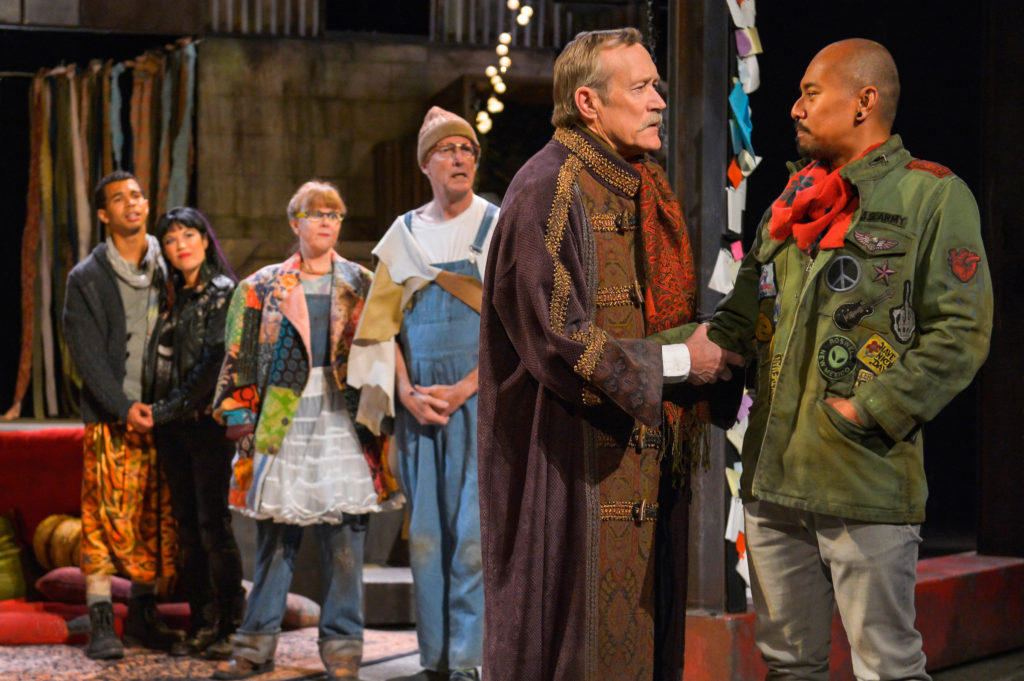
(L to R) William Thomas Hodgson (Silvius), Lisa Hori-Garcia (Phebe), Patty Gallagher (Audrey), Warren David Keith (Touchstone), James Carpenter (Duke Senior) and Jomar Tagatac (Jaques), photo by Kevin Berne.
Company stalwarts James Carpenter as both the usurping and deposed dukes, Patty Gallagher as the unsophisticated country- (or in this case, city-) bumpkin, Audrey, and Warren David Keith as the jester, Touchstone, are uniformly wonderful in their supporting parts. Maryssa Wanlass as Celia, Craig Marker as Oliver, William Hodgson as Silvius and Lisa Hori-Garcia as Pheobe complete the cast, in which there is no weak link.
Ending by Not Ending
The denouement of the play is always a little odd, as the text prominently features a deus ex machina for which we are even more than usually unprepared, but Chiang makes her most deliberate textual changes of the night to this ending by simply eliminating most of it. It is not just her Rosalind who has no desire to change back into a woman. The whole production is most comfortable in the transformative “green world,” and in the end it stays there. After the curtain call, Rosalind’s super hetero-normative epilogue is retained, but so peppered with gender-queer and LGBTQ-friendly asides from the rest of the cast that it ends by meaning exactly the opposite of what it says on paper… thank heaven.
CalShakes is the largest and most sophisticated of the Bay Area’s summer Shakespeare festivals. Its new artistic director, Eric Ting, seems determined to maintain and extend the company’s progressive reputation. In his own directing debut for the company last season, he produced a notable – and notably controversial – Othello, which was pointedly political, via a hyper-Brechtian performance style. As You Like It goes about making its social commentary in a more indirect way, but is every bit as revolutionary. What a great start to the Shakespeare season!
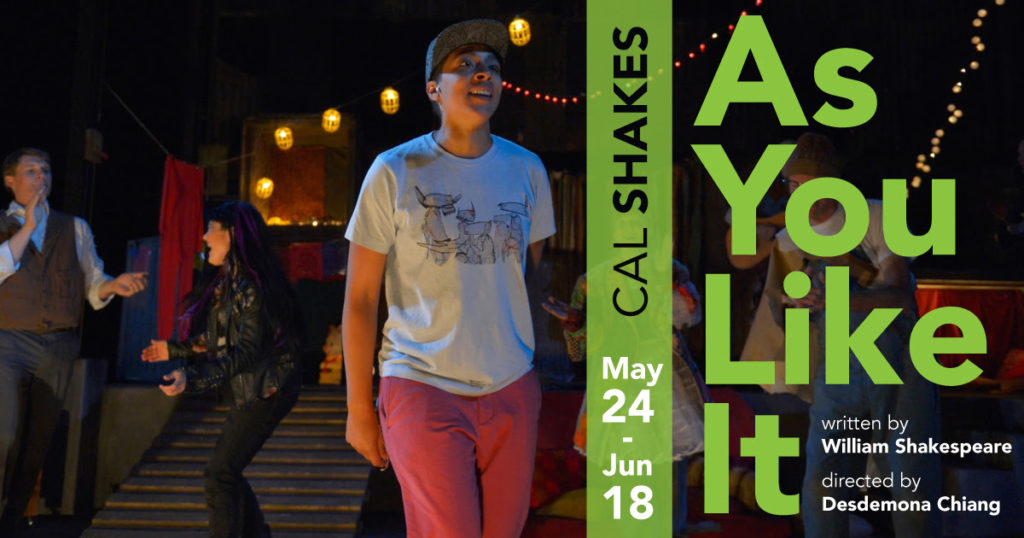
Production Information
AYLI, viewed on May 27, 2017
California Shakespeare Theatre
www.calshakes.org
(510) 548-9666
Tickets $20-96
Bruns Ampitheater, 100 California Shakespeare Theatre Way, Orinda, CA 94563
Tuesdays-Sundays through June 18
He were an excellent man: a review of MUCH ADO at CalShakes
May 30, 2016 § Leave a Comment
As has been their pattern for the last few years, the California Shakespeare Theater (CalShakes) has opened its season with a quirky, challenging take or adaptation of a Shakespeare play. (Last year it was an almost all-female Twelfth Night.) This year it is an adaptation of Much Ado About Nothing, which greatly streamlines the play, presented by a multi-ethnic and frequently gender-switched ensemble of eight.
Directed by off-Broadway fixture Jackson Gay, who also adapted the play with Kenneth Lin, the production is successful at condensing the sprawling plot into a tightly focused hour-and-a-half. It is especially entertaining when the gender-switched central couple, Beatrice (played by James Carpenter) and Benedick (played by Stacy Ross) hold the stage.
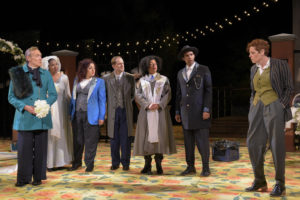
(l to r) James Carpenter as Beatrice, Safiya Fredericks as Hero, Denmo Ibrahim as Claudio, Anthony Fusco as Leonato, Rami Margron as the Friar, Lance Gardner as Don Pedro, and Stacy Ross as Benedick in California Shakespeare Theater’s production of MUCH ADO ABOUT NOTHING, directed by Jackson Gay; photo by Alessandra Mello.
Storming the Gates?
Conceptually, it is far murkier. Set, according to the advanced publicity, behind the scenes of “the biggest celebrity wedding in America,” where the catering staff acts out their pieced-together understanding of the story underneath the scandal-plagued ceremony they have just served, the adaptation succeeds best when speeding quickly past the issues of race and class it promised, in that same preview, to raise. Much Ado does not prove a very good vehicle for discussing income inequality or class privilege, largely because the original plot focuses so clearly on critiquing male privilege. Additional text by Kenneth Lin, mostly a smattering of amusingly snarky couplets, alludes to the notorious indifference of the one-percenters, but does little to further the social critique. (No rants from me against updating Shakespeare, or conceptual productions. I usually favor them. Just noting that, except in the arena of gender politics already present in the play, this particular concept did not have much to say.)
The location dictated by this concept (the untidy staging space behind a wedding venue) limited scene designer Erik Flatmo’s options. His realistic, but therefore messy, set worked well as a floorplan without giving us much to look at. The most prominent feature on the set, a second-story balcony where we are told the play’s thug, Borachio, created the illusion of seducing the confusingly named heroine, Hero, was not used for that, or really any, purpose. Of course that event is only related through exposition in the play, although it is often interpolated as a mime, but then if you are not going to stage it – echoing the issue with the overall concept – why is this feature there at all?
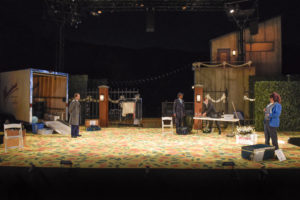
Erik Flatmo’s set for the California Shakespeare Theater’s production of MUCH ADO ABOUT NOTHING, directed by Jackson Gay; photo by Alessandra Mello.
Costume designer Karina Chavarin provides very effective pieces to be layered over the basic catering uniforms to indicate the fictional characters of the play. Visually, the heavy lifting is done by lighting designer Paul Whitaker, who not only shapes the stage with interesting compositions but helps us alternate between the framing device and the play itself with great dexterity.
Genderbending
What does work, and might have worked equally well without any added concept, is the virtuosity of the acting. The brilliant Anthony Fusco is underutilized in this production but alternates rigidly patriarchal Leonato with an “indignorant” Dogberry with speed and skill. Rami Margron, a company stalwart, is likewise used in the smallish parts of Margaret and Borachio, but single-handedly makes clear the power of cross-gender casting in the crucial but thankless role of the friar. Spoiler alert: after Hero is brutally rejected by her fiancé, her feudal lord and ultimately her father, it is the unassuming friar who steps forward to declare belief in Hero’s innocence of the charges of infidelity waged against her, and to provide the plan that ultimately resolves everything happily. In his one speaking scene, the friar explains that he knows Hero is telling the truth just by genuinely observing her reactions. Although in this production the character is still gendered male, watching a woman play the part provides a perspective on empathy that I have never experienced after seeing the role traditionally cast.
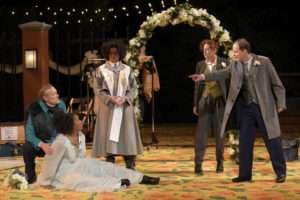
(l to r) James Carpenter as Beatrice, Safiya Fredericks as Hero, Rami Margron as the Friar, Stacy Ross as Benedick, and Anthony Fusco as Leonato in California Shakespeare Theater’s production of MUCH ADO ABOUT NOTHING, directed by Jackson Gay; photo by Alessandra Mello.
Stacy Ross gives us an original reading of Benedick through deftly handling the cross-gendering of her character so that she seems perpetually present as both the character and the underlying (female) cater-waiter presenting the story. Her intelligent interpretation of the part is informed by her gender, and we see her perspective in the way in which even she is surprised by the choices Benedick makes and the struggle to embody them.
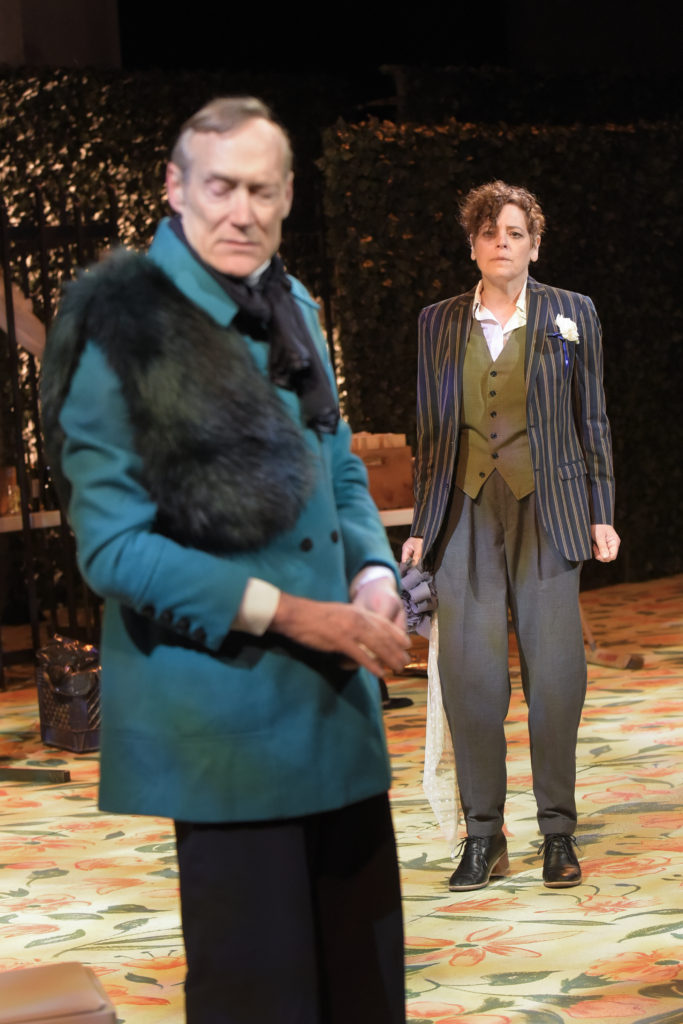
James Carpenter as Beatrice and Stacy Ross as Benedick in California Shakespeare Theater’s production of MUCH ADO ABOUT NOTHING, directed by Jackson Gay; photo by Alessandra Mello
The revelation of the night is James Carpenter in the role of Beatrice. He was seen a year ago cast perfectly to type in Pygmalion as Doolittle. It is hard to imagine someone less likely to play Beatrice, but he does it with such humanity and emotional grace that the part seems newly minted. Her pain and frustration reads as all the greater because it is clear (when situated on a male body) that they are entirely artificial limitations placed on her.
The versatile cast is rounded out by Patrick Alparone, Safiya Fredericks, Lance Gardner, and Denmo Ibrahim.
CalShakes is the big dog among Bay Area Shakespeare festivals. It has consistently high production values and standards. It is situated in the very diverse East Bay and has a great track record of developing and serving a contemporary audience. Much Ado does not quite deliver on its potential to comment on social disparity just down the freeway, but it is still a worthwhile night in the theatre–especially recommended for those who know the play well and are ready to see the traditional comedic war-of-the-sexes battle lines redrawn.
PS: CalShakes has a new artistic director, Eric Ting, who welcomed the audience warmly for this opening night but it will be later in the season, when he makes his directorial debut with Othello, before we get a full sense of what he will bring to the company.
Details:
California Shakespeare Theater’s production of Much Ado About Nothing by William Shakespeare, adapted by Kenneth Lin and Jackson Gay, with additional text by Kenneth Lin.
Directed by Jackson Gay. Designed by Eric Flatmo (set designer), Karina Chavarin (costume designer), Paul Whitaker (lighting designer), and Olive Mitra (sound designer/composer).
May 25–June 19, 2016
(Tuesdays through Thursdays at 7:30pm, Fridays and Saturdays at 8pm, Saturday Matinee June 18 at 2pm
Sunday Matinees at 4pm)
Bruns Amphitheater, 100 California Shakespeare Theater Way, Orinda, CA 94563
Dreaming of a Better World: A Review of LIFE IS A DREAM at CalShakes
July 12, 2015 § Leave a Comment
Attending the live theatre can be fun, intriguing, informative, provocative, entertaining, educational… but what keeps me coming back show after show is that every once in a while everything aligns and a night in the theatre is just magical. Such is the case with CalShakes’ beautiful, lyrical production of Calderón de la Barca’s Life is a Dream directed by the brilliant Loretta Greco.
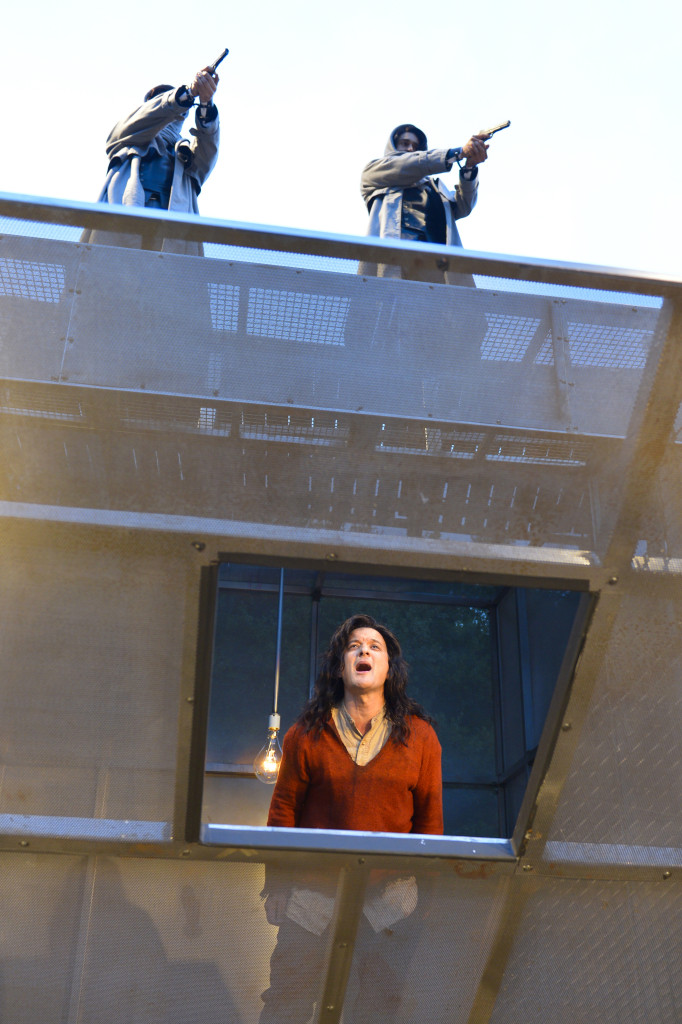
(Above) Carlos Berrera and Kaiso Hill; (below) Sean San José as Prince Segismundo in California Shakespeare Theater’s Life Is a Dream, directed by Loretta Greco; all photos by Kevin Berne.
Anything but Dry
Finding the heart of this Siglo de Oro (Spanish Golden Age) masterpiece is not easy. Usually called a “philosophical drama,” it is, on the rare occasions when is performed, often cold and mechanical. The opposite was the case here. Pulitzer-prize winner Nilo Cruz’ (Anna in the Tropics) translation and adaptation was a key to capturing the shimmering other worldliness – that quality that was later to be called “magic realism” – that permeates the original, but seems so elusive in English.
(That the drama of the Spanish renaissance is so shamefully neglected on the stages of Shakespeare festivals – despite the fact that here on the West Coast a plurality of the population is of Hispanic heritage – especially when French farce is such a staple, is a rant for another day. For now, let me just honor Artistic Director Jonathan Moscone’s opening night statement that it is exceptionally difficult to find the right artist to “unlock” these plays. Greco is absolutely the right artist!)
A Son Betrayed
La vida es sueño tells the story of a crown prince, Segismundo, imprisoned and isolated from birth because ill-omens suggested he would become a oppressive tyrant and overthrow his father, who is drugged and brought to court for one day as a test before one of his cousins is named heir in his place. It is a test that he fails miserably, having known nothing but a brutish, caged existence. The tiny bit of education and philosophy given him by his sole caretaker, a nobleman named Clotaldo, cannot steer him through his first encounters with luxury, power, and especially with the lust he feels when he encounters women for the first time. After a disastrous day, he is again drugged and returned to his cell, where he is led to believe that it was all nothing but a dream. Clotaldo suggests that what he can learn from his “dream” is that it is important to strive for goodness and mercy at all times, even where it seems one has no control.
Segismundo’s existence having become known, however, sets off a civil war and he is freed by his people who refuse to accept the rule of the foreign-born cousins. Now unable to distinguish what is real and what is imaginary so reliant only on pure principle, Segismundo successfully leads the rebellion and conquers the father that has so painfully betrayed and abandoned him, leading to a stunning final encounter.
Otherworldly Beauty
Cruz’ translation and Greco’s production set this story indefinitely in both time and space. Andrew Boyce’s graceful set is a single platform that spirals into the sky above a plain metal box that serves as a cell. Guns and steel suggest the time is not “then,” while capes and swords suggest that it is also not “now.” No geographical references occur at all. Alex Jaeger’s vaguely period costumes and the crystalline illumination by Tony-award winning light designer Christopher Akerlind create a world that is both accessible and ephemeral.
Greco does not make any contemporary references explicit, but the inescapable parallels to repressive regimes, betrayed generations and the seeming unreality of much of modern life float forward anyway. A light touch has a huge impact.
Stunning Cast
Segismundo is usually played by a Hamlet-like tragic hunk, but the revelation of the night was the extraordinary central performance by the man-child Sean San Jose. His simple awe at everything he encountered coupled with his quick, deep connection to his emotions made his transcendent performance moving beyond description.
The moral center of the play is Clotaldo, caught between loyalty to his king and his duty as caretaker to Segismundo. Julian López-Morillas, an artist with long and deep ties to this community, brought to the role the same intensity and humanity that illuminated his revelatory performance as Geronimo in Marin Shakespeare’s The Spanish Tragedy two seasons ago.
Performances of the play usually fall apart around the tangential sub-plot about a young woman seduced and spurned by Segismundo’s cousin, Astolfo. Never having known her father, and unable to find any champion, she sets off in male disguise and with a comic side-kick to seek revenge, where she encounters Segismundo in his prison and eventually finds her real father and her destiny. Even bravura performances often fail to make the role rise above the improbability and coincidence.
In the hands of Sarah Nina Haydon, however, this Rosaura becomes something else. She finds her own suffering parallel to Segismundo’s, not least because of the way that it keeps intensifying through circumstances that she experiences as surreal. Her life is as nightmarishly dreamlike as is the protagonist’s, and as revealed by the delicate handling of her performance under Greco’s direction, as ours.
The cast is uniformly superb. Amir Abdullah is charismatic as the complex cousin Astolfo. Company favorite Tristan Cunningham has never been better utilized than she is as the radiant competing cousin Estrella. Adrian Roberts is a commanding presence as the conflicted king. Jomar Tagatac is by turns hilarious and then devastating as Rosaura’s pragmatic side-kick. Even the unnamed parts were fulfilled brilliantly by Carlos Barrera, Kaiso Hill and, especially, a compelling Jason Kapoor – whose reappearance in multiple roles rose above utilitarian and became yet another element that made the production feel dreamlike.
Another Dream Play
When the play finally reaches its climax, with the conquering Segismundo facing down his self-serving father, honest but inadequate tutor, love-interest who is in love with somebody else, and scheming cousins, the adaptation by Nilo Cruz takes an unexpected turn away from the predictably mundane resolution of the plot and leaps into the poetic heights reminiscent of Shakespeare’s dream play, Midsummer. It is a gasp-inducing conclusion that feels perfectly suited to the cultural moment. Theatre does not get better than this.
Life is a Dream
Playing through August 8, 2015
California Shakespeare Theatre
July 11, 2015
Top Girls: A Review of TWELFTH NIGHT at CalShakes
June 2, 2015 § Leave a Comment
With its almost-all-female Twelfth Night, CalShakes has set a very high bar in what is emerging as “the summer of the woman” among Bay Area Shakespeare Festivals. Concerned with the lack of opportunity traditionally cast productions offer women, both the San Francisco Shakespeare Festival and Santa Cruz Shakespeare have announced they will perform with casts that have gender parity. Sacramento Shakespeare is performing an all-female As You Like It (along with an all-male Romeo and Juliet), and even companies with more traditional approaches seem to be producing an unusual number of plays with featured female protagonists this summer.
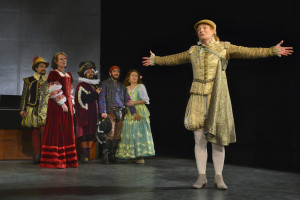
Lisa Anne Porter as Viola and the cast of California Shakespeare Theater’s production of TWELFTH NIGHT, directed by Christopher Liam Moore; photo by Kevin Berne.
The Challenge of Cross-Gender Casting
Achieving more opportunities for women is not as simple as it sounds, however. Shakespeare’s plays (written originally for an all-male troupe) have a limited number of female roles – four or fewer per play – in comparison to the dozen and up male parts. That number might be improved slightly because occasionally there are parts that do not really have a gender, like the narrator, Chorus, from Henry V, that can be easily cast with women. And there are numerous small roles that can be re-gendered safely, but how great a break-through is it to be allowed to play “2nd servant” in a dress? Such condescension is often more objectionable than not being cast. Finally, of course, there is the possibility that some women can undetectably pass as males, but that is a very limited casting pool and is not the opportunity of which most actresses dream. There are, therefore, a very limited number of ways that one can produce the plays, at least in a traditional way, that does much to address the problem.
The exercise only becomes interesting for both audiences and actors when women play “male” roles from their own viewpoint, bringing fresh and exciting perspectives to narratives about which we have grown complacent. Last fall, in her terrific solo show, Shakespeare and the Alchemy of Gender, the great Lisa Wolpe demonstrated a knack for imitating the physicality and vocalization of men – especially tragic heroes – but became revelatory when she assumed (and simultaneously “commented” upon) the attitudes of male privilege. What makes her so exciting as our reigning “Shakespearean drag king,” is that we never lose sight that she is a woman who sees how “maleness” is constructed and rewarded, and not that she does some kind of perfect impersonation.
A Man Among (Wo)Men
CalShakes takes a much more light-hearted, but no less revelatory, approach in its beautifully rendered Twelfth Night. Director Christopher Liam Moore finds myriad ways for his cast of seven women and one man to illuminate the play’s thematic gender confusion. Ted Deasy, making his area debut but familiar to many audience members from his work at the Oregon Shakespeare Festival, is cast as the jester, Feste. He also doubles virtually every unnamed character in the play (the Captain, the arresting officer, the priest, etc.). Deasy is nothing short of brilliant as the fool and entertainer – rendered as a purposely anachronistic country and western singer. His portrayal of Antonio, the sea captain hopelessly in love with the young man he saves from drowning, is heartbreaking. His finesse at playing multiple roles, sometimes simultaneously (as when he hilariously arrests himself), is the stuff for which one would ordinarily praise this production to the skies. (Deasy, the only man in the cast, playing ALL the drudge roles is, in itself, an interesting comment.)
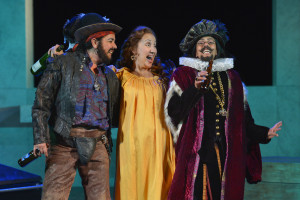
(L to R) Catherine Castellanos as Sir Toby Belch, Domenique Lozano as Maria, and Margo Hall as Andrew Aguecheek. photo by Kevin Berne.
Beards
Outstanding as he is, however, it is the women who rock the night. Catherine Castellanos, whose Toby Belch is all codpiece, gives an incisive portrait of a particular kind of male cloddishness. The falseness of her false beard is quite pointed – her aim is not sincere imitation, but satire. Her partner in crime is the brilliant Margo Hall, whose Sir Andrew Aguecheek is so effeminate that we cannot help but see how artificial our gender constructions can be. Hall is hilarious, precisely because of the incompletely digested gender codes her character displays. Remi Margron completes the trio of false-facial haired characters with a love-sick Orsino whose emotional range was far greater, and more convincing, than any that I can ever recall seeing.
And a Lack-Beard
Perhaps the most interesting creation of the night was Stacy Ross in the role of Malvolio. Unlike the bearded bunch, she was costumed and made-up in a way that scarcely bothered to nod toward maleness. Hers is not a particularly masculine face, and no attempt was made to alter it or her figure. If anything, in fact, her cassock looked (as they inevitably do) rather like a dress. The character was intensely interesting because the focus on her puritanical nature had almost nothing to do with gender at all. Later, having fallen prey to the deceitful trick that made her believe her mistress was infatuated with her, it was her shocking lack of a male conception of masculine display that provided the humor (and, of course, the larger commentary) as she writhed around in her yellow garters and a strategically placed giant yellow bow.
Women Playing Women
The cast also featured women in the traditionally female roles, particularly Julia Eccles as Olivia, and Domenique Lozano as Maria, and the contrast was exquisite. For once, one sympathized with Olivia’s impatience with Orsino’s relentless onslaught. In contrast to him, her maturity and composure were striking. All the more powerful, then, was the effect of her coming unglued at the sight of Cesario, who is actually the disguised Viola. One also understood that Maria was saving Toby, not simply failing to see through him.
The evening turned on the performance of Lisa Anne Porter as both the twins Viola and Sebastian. Except for their attitudes toward fighting, almost nothing distinguished them, which turned out to be the best decision of the night. Viola is already “playing a man” in her disguise as Cesario, which we often feel in performance she is not doing very well because a very distinctly male person is being directly compared to her every time Sebastian comes onstage. In this case, however, the twins were truly identical – and the artificiality of gender constructions was highlighted in a way I have not previously experienced. The reality of what Viola was giving up by trying to live by men’s rules was heartbreaking, and the ease with which her brother was granted everything he wanted without so much as asking for it was shocking.
The manner in which the play resolves, in a scene with both twins onstage, was well-handled directorially and perfectly appropriate for the play, but was less surprising than it might have been to anyone who saw the company’s production of Comedy of Errors last season, which used the same convention and virtually the same staging for its final moment.
The Spice of Life…and Art
It would be a mistake to suggest that the performance was didactic about its non-traditional casting. Far from it; it was subtly employed in a marvelously entertaining evening. Nonetheless, successful cross-gender casting is challenging. What was so smart about this particular production is that almost as many approaches as cross-gendered parts were employed. It was the variety that most amazed, and in the end, spoke most eloquently for the practice.
Nina Ball’s beautiful set, a sleek family crypt with an ever-present coffin to remind us that the play is essentially a memento mori, was stark and efficient. It featured a large central opening that allowed us to see Burke Brown’s beautiful lighting of the natural landscape in the distance as well as his subtle and effective illumination of the action. Along with Meg Neville’s delightfully detailed period costumes, the visual element helped explain – along with the adventurous non-traditional approaches it has repeatedly employed – why CalShakes has emerged as the premiere classical company in the Bay Area. Performances continue through June 21 – plenty of time to see this highly recommended production.
Details:
Twelfth Night
Presented by the California Shakespeare Theater
Bruns Amphitheatre, Orinda, CA
May 30, 2015
Review: ROMEO AND JULIET at CalShakes
July 8, 2013 § 2 Comments
Can it be that the most “authentic” production of a Shakespeare play I’ve seen in years is a modern-dress production of Romeo and Juliet with a cast of seven performing a heavily cut text, accompanied by a pulsing club-inspired sound design? To my great surprise, I believe so.
As a professor of both acting and theater history, I think a lot about what the experience of seeing an original performance of a Shakespeare play must have felt like. It is the effect that I would most want to capture, not the form. We can do a reasonably good job at recreating the look and style of the late sixteenth century theater, but what would have been innovative, contemporary, and engaging then often seems hopelessly stale and distant now that the context has completely changed.
Shana Cooper’s Romeo and Juliet, now playing at the California Shakespeare Theatre near San Francisco, is a stark but simply brilliant, production. It is as far from a museum replica version as possible, yet it recreates all of the Shakespearean theater’s virtues in modern form.
Played on an open stage against no scenic backdrop but the Orinda, Ca. landscape behind CalShakes’ outdoor auditorium, Cooper uses a text-based technique right out of the Elizabethan theater to verbally move us instantly from imaginary location to location on Daniel Ostling’s aggressively thrusting platform set. The visual neutrality focuses all attention on the action, but when it pauses to be beautiful it is breath-taking. Romeo defying stars that you can actually see causes an exhilarating, visceral rush. Lap Chi Chu’s lighting design for the stage is effective, but his subtle lighting of the natural background in the distance, particularly in the eerie tomb scene, is genius.
Performed by an incredibly versatile cast of three women and four men playing some twenty roles in a heavily but skillfully edited version, it was energetically engaging for every moment of the promised (accurately, for once) two hours traffic on the stage. Somewhere between a quarter and half of the traditional text was excised, including all the bit parts. In clumsy hands, that might have given the appearance of financial expediency, but here it focused and sped the narrative so that events felt – as they should – like they were spinning out of control. Early in the second half the scenes in which Romeo and Juliet separately learn he has been banished were intercut in a way that seem stunningly cinematic or, well, Shakespearean. The juxtaposition of the simultaneous scenes was inspired.
The modern dress costumes enhanced the youthful, often rude energy of the performances. Although the period was changed to some quasi-now (where fourteen-year-olds can still be married off at a father’s whim), it read less as a resetting and much more a case of simply becoming invisible to us. I suspect this is the way that contemporary dress on the Elizabethan stage might have affected the Shakespearean audience – it faded into the background, as neutral as the scenery.
The performances were uniformly outstanding. Rebekah Brockman was an unusually aggressive Juliet from her first entrance when she jumped out to frighten the nurse. She has just finished a run of the season’s best production, playing Thomasina in ACT’s Arcadia. Perhaps it is because she was so indelible in that role that she seemed to possess the same combination of tragically under-appreciated intelligence and irrepressible, emerging sexuality here, but it is more probable that she carried it forward to create an equally self-inventing Juliet.
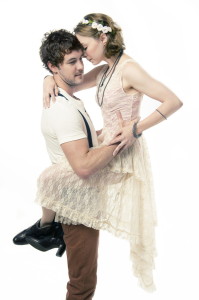
Dan Clegg (Romeo) and Rebekah Brockman (Juliet) in Cal Shakes’ Romeo & Juliet, directed by Shana Cooper; photo by Kevin Berne.
Romeo can be one of the least rewarding roles in the canon. He works incredibly hard in the first half of the play and then slowly fades from view in the second as Juliet’s story eclipses his. Dan Clegg brought unusual charm and skill to the part, and greatly benefited from the extensive cutting of Romeo’s mopiest and dopiest moments. He emerged as a genuinely tragic figure in the tomb scene, most moving when he unsuccessfully sought to scare Paris away to avoid killing him.
The other five cast members all played multiple roles with theatrical verve that made the production electrifying. Nick Gabriel (another veteran of the Arcadia cast) played Tybalt and Paris as entitled hipsters. Domenique Lozano doubled the Prince of Verona with the nurse, and excelled at both parts of this unlikely pairing. Arwen Anderson was a mousy Lady Capulet, but revelatory as Benvolio, where she out-guyed the guys when being one of the guys. Joseph J. Parks was the engine of the first act as the relentlessly and inappropriately libidinous Mercutio. It is, of course, necessary that this comic presence disappear from the last half of the play, and Parks is too irrepressible to hide effectively, but it is too bad that he could not be used for more than a cameo as the apothecary after intermission. He is too good to sacrifice.
The production ultimately rests on the skills of Dan Hiatt, who is onstage almost continuously in the second half as Friar Laurence, quick-changing into Lord Capulet, and then reappearing as the servant Peter. That he could walk to the edge of the platform, slip on a jacket, and return instantly as someone else for scene after scene was a confirmation of what every regular theater-goer in the Bay Area already knows: he is a consummate actor. It is worth the price of admission just to watch his transitions.
The production is so tightly focused, suiting the action to the word and the word to the action, that it is immediately affecting while serving as a model of narrative clarity. One might quibble with the unusual choice to strangle rather than stab Tybalt, only because it renders later references to shedding his blood very odd, but Shana Cooper’s direction is otherwise flawless. The fast-moving staging, stylized fights, smart transitions and beautiful use of the natural surround as scenery combined for the most rewarding (and least gimmicky) Shakespeare I’ve seen in ages. It was fresh and exciting.
I walked away thinking, “I bet that is exactly how it felt at the Globe.”
